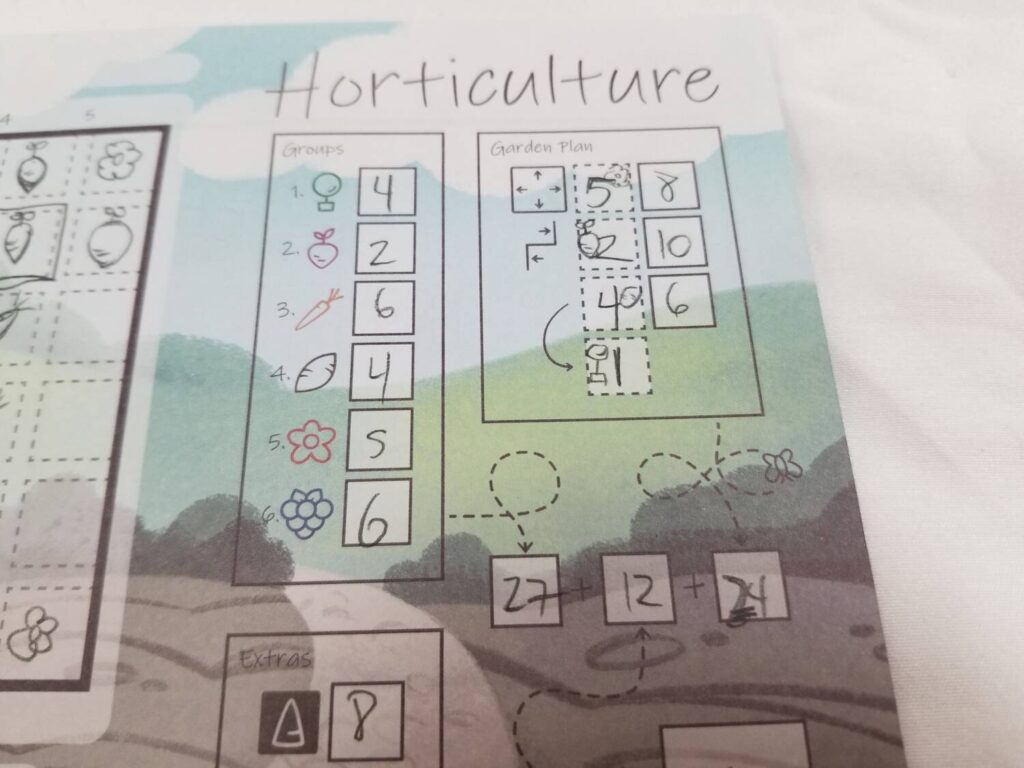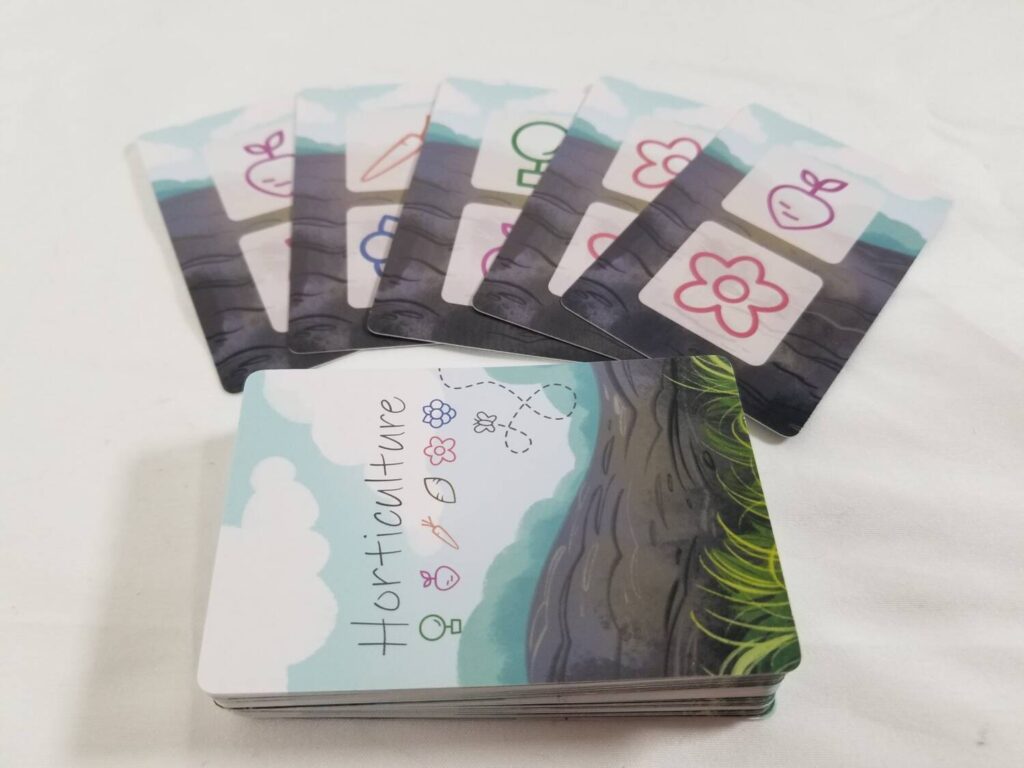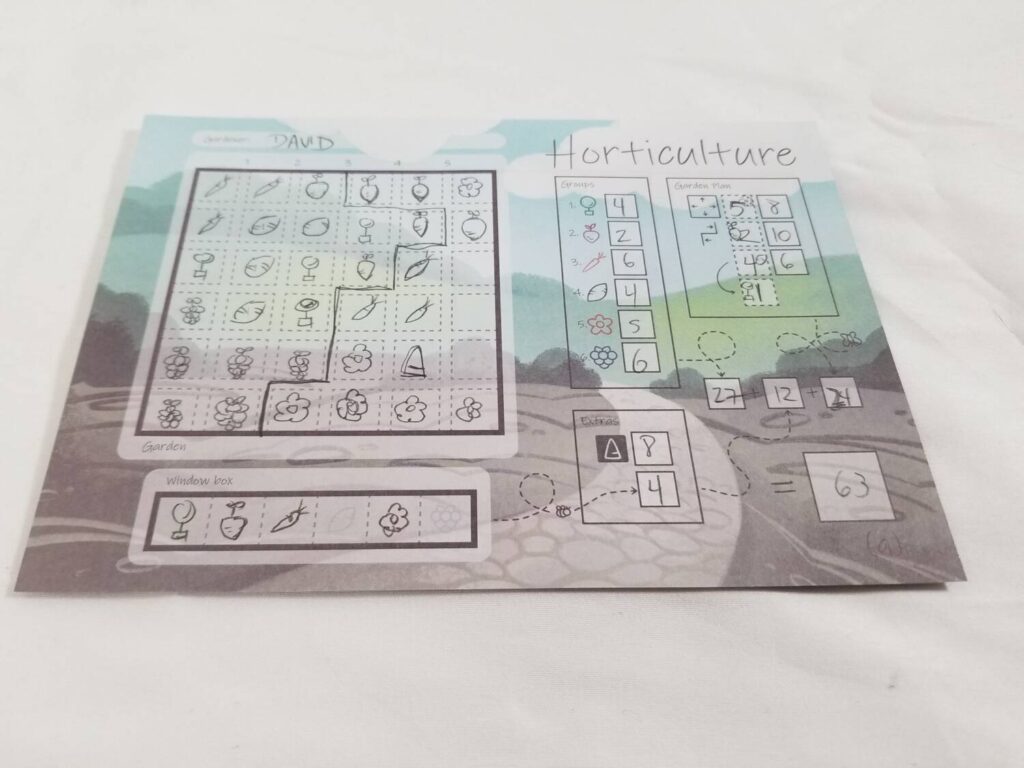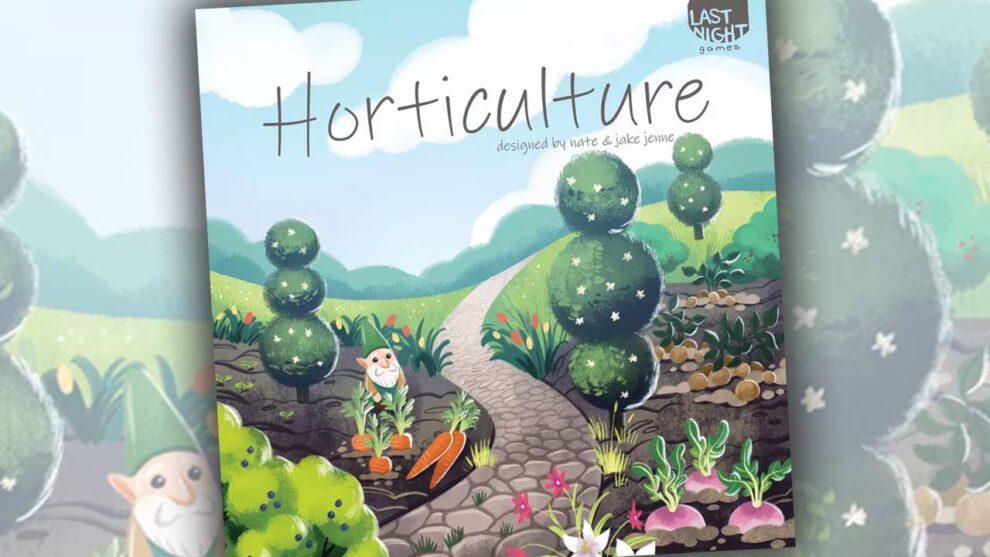Disclosure: Meeple Mountain received a free copy of this product in exchange for an honest, unbiased review. This review is not intended to be an endorsement.
Horticulture – noun
- the cultivation of a garden, orchard, or nursery; the cultivation of flowers, fruits, vegetables, or ornamental plants.
- the science and art of cultivating such plants.
- a fast-paced game of calling your shot and tending your plot.
In the game of Horticulture, players take on the roles of gardeners competing to build the most beautiful, not to mention highest scoring, garden. In the game, the gardeners are all members of a co-op and they’re forced to plant whatever the other gardeners return with from the local nursery. Sometimes the other gardeners’ choices will work in your favor, easily fitting into your garden plan, but just as often, not fitting into your plans at all.
Overview
Horticulture is a member of the ‘roll and write’ classification of games, although it’s more accurate to call it a ‘flip and fill’. Each player’s garden is created on a sheet of paper as the game progresses. Players take turns drawing two cards from a shared deck of cards, choosing one to keep and one to discard. Each card features two symbols representing one or more of the various types of plants in the game. After a card is selected, the players must add the symbols shown on the card to their garden following some simple placement rules.
The objective is to add icons to your garden such that they form connected groups of the same kind in order to earn higher point payouts while also adhering to your garden plan that you will have set for yourself at the start of the game. The better you are able to adhere to your plan, the more points you’ll earn. And once the game comes to a close, the player with the most points wins.
Of course, this is a high-level overview of the game. If you think you’ve heard enough and just want to know what I think, feel free to skip ahead to the Thoughts section. Otherwise, read on as we learn how to play Horticulture.
Setup
A game of Horticulture is set up thusly:

Each player is given a Garden sheet and a pencil. The Plant cards are shuffled to form a deck and a certain number of cards from the deck are removed (based on player count) and returned to the box.
Next, the players will simultaneously plan their gardens. Each player decides which plants they hope to plant along the outer borders of their garden, which plants they hope to plant adjacent to the garden path, and which plants they hope to build next to one another. Then, the gardeners will add their gnome to their garden. The gnome will score a varied number of points at the end of the game, determined by which groups of plants are orthogonally adjacent to it.

Once this is done, beginning with the starting player and going in turn order, the players are going to work together to draw a garden path on their Garden sheets. The starting player will call out a starting location on the edge of the board (location 3, for example) and will draw a line downward from the 3 to the intersection. The other players draw the same line in the same position. Then, the next player in order will call out a direction (right, for example) and will draw a line to the next intersection. The other players draw the same line in the same position. This continues in this fashion—with each player in succession calling out the next line position, drawing it, and everyone else following suit—until a garden path extending from the top and snaking through to the bottom has been completed.
Now you’re ready to play Horticulture.
How It’s Played
The actual mechanics of a game turn in Horticulture are very easy to wrap your brain around. On your turn, you’ll draw 2 cards from the deck, choose one to keep, and discard the other. Then, every player must draw the indicated plants somewhere on their Garden sheet following these simple rules:
1. Plants can only be drawn into boxes that are adjacent to previously filled in boxes, adjacent to the gnome, or adjacent to the garden path.
2. A player may opt to plant one of the plants into their window box. However, the window box can only accommodate one of each type of plant.

After drawing in their plants, the next player in line becomes the new starting player and they begin the next round. Rounds are played out in this fashion until the deck of cards runs out. Then scores are tallied.
Scoring
Each type of plant has a numeric value associated with it and this value indicates how many of this plant must be clustered together in your garden in order to create a ‘group’. Topiarys, for instance, have a value of 1. So, a single topiary hanging out by itself is considered a group. Whereas, sweet potatoes have a value of 4, so you would need at least 4 of these clustered together to create a group. This is an important concept to understand because it’s critical for scoring.

First, each group of each plant type is tallied and is multiplied by the numeric value of the plant being counted to determine the score for that plant. For instance, if you had 2 groups of sweet potatoes, you would score 8 points (2 groups x the numeric value of 4) for sweet potatoes.
Next, score how well you adhered to your garden plan. Count up the number of plants along the border matching the type you’d hope to plant along the border. Score 2 points for each of these. Score 2 points for every plant bordering the path matching the type you hoped to plant alongside the path. Then, for every pair of plants matching your companion plant plan, score an additional 2 points.
Then, score for your gnome. For every cluster orthogonally adjacent to the gnome that forms a group of plants, score points equal to the plant type’s value. And, finally, score 1 point for each plant drawn into your window box.
All the scores from the various areas are added together to determine your final score, and the person with the highest score wins.
Thoughts
Here’s a weird truth about being an avid gamer who’s also the parent of a young child. Sometimes the games you’d normally never play become the only games you can actually play. I’m a person that enjoys meaty euros—the meatier, the better. But those kinds of games come with a hidden price tag beyond, you know, the actual price: they take a lot of time to play. Once upon a time, I could sit down with my wife and play a 2 or three hour long game each evening. But those days are long gone. These days, I take what I can get. When a fast-playing roll and write like Horticulture comes my way, I don’t turn it down. Whereas past David might have scoffed at a game like Horticulture, present David is, if not a lot wiser, a lot more accommodating.
When Horticulture was offered to Meeple Mountain for review, I took a look at it to determine whether or not it was a game that I thought I could actually get to the table.
Right away, Horticulture ticked a lot of boxes for me. For starters, it’s small in stature. A two-player game of it (and quite possibly a 3-player) can easily fit on top of a standard sized TV dinner tray. Secondly, it’s portable. The box is smaller than a hardback novel, easily fitting inside a backpack, perfect for those occasions when you’ve got a lunch break with a friend and 15-20 minutes to spare. And that brings me to my next point: Horticulture is a quick game, and I’m not just talking about the gameplay. From setup to playthrough to breakdown, the entire experience only takes 10-15 minutes.
Knowing that I could fit it into my lifestyle, I volunteered. From a purely logistical standpoint, it had a lot going for it. But, was it any good?
The answer to that question is an emphatic “Yes!”. Horticulture is pretty excellent. Physical dimensions aside, there’s a lot of game in this small package.
What sets Horticulture apart from other roll and writes of its nature is that you are setting your own parameters before the game even begins. Most games like Horticulture are purely reactionary: your world takes shape as the game progresses, only bounded by the strictures laid out in the rules. You can start anywhere and do anything so long as what you do doesn’t violate this rule or the other. Horticulture, on the other hand, is more confined. While you could technically just plant stuff wherever you wanted, it’s unadvisable to do so. If you want to score well, you are going to have to adhere to your garden plan as much as possible.
While the possibilities may seem boundless, those plans you set for yourself before the first card was ever flipped operate as a sort of invisible fence, enforcing boundaries without you even realizing it.
Operating within those boundaries is what makes the game challenging. Oftentimes, the card that was selected is not going to fit into your plans. You’re going to be stuck having to draw in stuff you really don’t need or want. How do you deal with it? Can you turn it to your advantage? Do you send this useless carrot to your window box or do you add it to your garden plot with the intention of surrounding it with other carrots later on? And, if you choose to keep them, where do you put them? Is there even room for them? Will adding carrots mean having to scrap some other plan? Is it even worth it?
Operating within those boundaries isn’t just challenging because you are having to operate within them, but also because everyone else is as well. When you’re the one flipping cards, the decision of which plants to keep isn’t always an easy one. Do you keep what’s useful to you or do you keep what’s going to cause your opponents the most grief? After all, your garden plan is right out there in the open for anyone to see, providing they care to look.
And that segues nicely into Horticulture’s greatest strength, which, ironically, is also its greatest weakness. Horticulture can accommodate a lot of players, the rulebook says up to 10. The highest player count I’ve played it at was 8. In a 3-4 player game, it’s easy to look across the table at other people’s sheets to see what they’re after. This is not as easily done with 8 people. And, at 8 people, the teach is a bear. Horticulture is a game more easily taught when people can see visual examples of what you’re talking about. Trying to explain the nuances of garden planning and scoring to a table of 8 people using a tiny garden sheet was challenging, to say the least. Not to mention, I had to field twice as many follow-up questions as I did in a four player game. I guess the point I’m trying to drive home is, if you’re thinking of playing Horticulture with a large group of people, be forewarned. You’re going to have your hands busy.
In the long run, Horticulture’s positives far outweigh its one and only negative. I’m glad I took it on. It’s a fun game that fits nicely with my busy parent lifestyle. If you’re able to squeeze an extra 10-20 minutes of gaming out of your day, I’m sure you’ll find it fits yours, too.












Add Comment